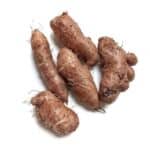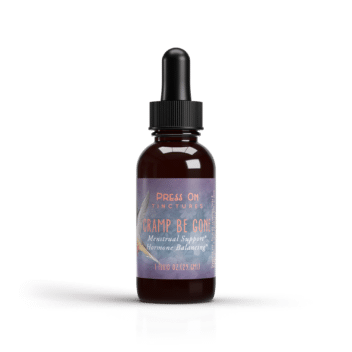
Wild Yam
Describe Wild Yam for Herbal Medicine
Wild yam, scientifically known as Dioscorea villosa, is a tuberous vine native to North America. It has heart-shaped leaves and typically grows in woodlands and thickets, thriving in the rich and moist soil found in these environments. The plant is often recognized for its knobby roots, which hold the key to its medicinal properties. These roots contain diosgenin, a compound that can be converted into steroidal saponins, making wild yam a natural precursor to certain hormones. This unique composition has sparked interest in its potential to influence hormone-related health issues.
Beyond its chemical composition, wild yam’s resilience and adaptability contribute to its sustainability as a medicinal resource. Its ability to thrive in various conditions without extensive cultivation makes it a viable option for natural health practices. The plant’s historical use by indigenous cultures further underscores its importance, highlighting the deep-rooted knowledge that has been passed down through generations.
Historical Uses of Wild Yam
Wild yam has a rich history in traditional medicine. Native American tribes used it to treat a variety of ailments, including pain and inflammation. It was also employed as a remedy for digestive issues and as a natural antispasmodic to ease muscle cramps and spasms. These early applications laid the groundwork for modern uses, as many of the conditions treated by Native Americans are still prevalent today.
In addition to its use in pain management, wild yam played a significant role in the treatment of ailments related to the female reproductive system. Its application in easing childbirth and regulating menstrual cycles highlights its longstanding association with women’s health. The plant’s versatility is evident in its historical applications, which were not limited to a single system or condition but spanned a wide range of health concerns.
Women’s Health and Wild Yam
One of the most notable uses of wild yam is in women’s health. Many women have turned to wild yam as a natural alternative to hormone replacement therapy (HRT). The diosgenin found in wild yam can mimic the effects of progesterone, a hormone crucial in regulating menstrual cycles and supporting pregnancy. This has made wild yam an attractive option for those seeking natural solutions to hormonal imbalances.
The plant’s influence on women’s health extends beyond hormonal balance. Its potential benefits in alleviating symptoms associated with menopause and menstrual discomfort make it a versatile tool in women’s health regimens. By offering a natural alternative to synthetic hormones, wild yam empowers women to explore holistic health practices tailored to their unique needs.
Menstrual Health
Wild yam is believed to help balance hormones, which can be particularly beneficial for women experiencing irregular menstrual cycles or premenstrual syndrome (PMS). By acting as a natural antispasmodic, wild yam may help relieve menstrual cramps and discomfort, making it a popular choice for women seeking natural relief. Its soothing properties provide comfort during the often challenging premenstrual phase.
Additionally, the plant’s potential to regulate menstrual cycles can lead to a more predictable and manageable monthly experience. This predictability can be empowering, allowing women to plan and manage their lives with greater ease. As a natural alternative, wild yam offers a gentle approach to menstrual health, minimizing the reliance on over-the-counter medications that may have unwanted side effects.
Menopause Support
As women approach menopause, hormonal fluctuations can lead to a range of symptoms, including hot flashes, night sweats, and mood swings. Wild yam cream, a topical application derived from the plant’s roots, is often used to alleviate these symptoms. The cream is absorbed through the skin and may help balance hormones, providing relief for menopausal women. Its topical application offers a targeted approach, addressing specific areas of discomfort.
The use of wild yam cream can also contribute to an overall sense of well-being during the menopausal transition. By potentially reducing the severity of symptoms, it allows women to maintain a higher quality of life. This is particularly valuable during a time when many women experience significant physical and emotional changes. The cream’s ability to deliver diosgenin directly through the skin makes it a practical and effective tool in menopause management.
Wild Yam Cream Benefits
The benefits of wild yam cream extend beyond menopause support. This topical application has gained popularity for its potential to improve skin health and reduce inflammation. Its versatility in addressing both hormonal and dermatological concerns makes it a valuable addition to holistic health practices.
Skin Health
Wild yam cream is often praised for its moisturizing properties. It can help soothe dry and irritated skin, making it a valuable addition to any skincare routine. The cream’s natural compounds may also promote skin elasticity, helping to reduce the appearance of fine lines and wrinkles. This anti-aging potential has made wild yam cream a sought-after product in natural skincare.
Furthermore, its ability to nourish and hydrate the skin can contribute to an overall healthier complexion. Regular use of wild yam cream may lead to smoother, more resilient skin, enhancing one’s natural beauty. Its plant-based formulation appeals to those seeking a chemical-free approach to skincare, aligning with the growing demand for organic and sustainable beauty products.
Anti-Inflammatory Properties
Inflammation is a common underlying factor in many health conditions. The diosgenin in wild yam has been studied for its anti-inflammatory effects. When applied topically as a cream, it may help reduce inflammation and provide relief for conditions such as arthritis and muscle pain. This anti-inflammatory action is beneficial for those seeking natural methods to manage chronic pain and inflammation.
The soothing properties of wild yam cream can also support recovery from minor skin irritations and injuries. By addressing inflammation at its source, it promotes healing and reduces discomfort. The cream’s dual action as both a moisturizer and anti-inflammatory agent makes it a versatile addition to any natural remedy toolkit.
How to Use Wild Yam
Wild yam is available in various forms, including capsules, tinctures, and creams. When considering wild yam for medicinal purposes, it’s important to consult with a healthcare professional to determine the appropriate form and dosage for your needs. Understanding the different applications and their benefits can guide users in selecting the most suitable method for their specific health goals.
Capsules and Tinctures
For those seeking the internal benefits of wild yam, capsules and tinctures are popular choices. These forms provide a convenient way to consume wild yam and can be easily incorporated into a daily routine. Capsules typically contain a standardized extract of wild yam root, while tinctures offer a liquid alternative that can be added to water or juice. This flexibility allows users to tailor their intake to their personal preferences.
The standardized dosage in capsules ensures consistency, while tinctures offer the advantage of adjustable dosing. This adaptability makes wild yam accessible to a wide range of users, from those seeking mild supplementation to those requiring more substantial support. As with any supplement, following dosage guidelines and consulting with a healthcare provider ensures safe and effective use.
Creams and Topical Applications
Wild yam cream is applied directly to the skin and can be used as needed to address specific concerns. Whether you’re seeking menopause relief or improved skin health, it’s important to follow the instructions on the product label and consult with a healthcare provider if you have any questions or concerns. Proper application ensures optimal absorption and effectiveness.
The topical approach allows for targeted treatment, addressing specific areas of concern without affecting the entire body. This localized application is particularly beneficial for those with sensitive systems or who prefer to avoid oral supplements. By applying the cream directly to the area of discomfort, users can experience relief quickly and efficiently.
Precautions and Considerations
While wild yam is generally considered safe for most people, it’s important to be aware of potential side effects and interactions. Some individuals may experience mild digestive discomfort when taking wild yam internally. Additionally, those with hormone-sensitive conditions should exercise caution and consult with a healthcare provider before using wild yam. Understanding these precautions helps ensure safe and effective use of this herbal remedy.
Allergies and Sensitivities
As with any herbal remedy, it’s important to be mindful of potential allergies or sensitivities. If you have a known allergy to plants in the Dioscoreaceae family, it’s best to avoid wild yam. Conducting a patch test before widespread topical use can help identify any adverse reactions and prevent discomfort.
For those with sensitive skin or a history of allergies, monitoring for any signs of irritation is crucial. Discontinuing use at the first sign of an allergic reaction can prevent more serious complications. This cautious approach ensures that the benefits of wild yam can be enjoyed safely and without adverse effects.
Pregnancy and Breastfeeding
Pregnant or breastfeeding women should consult with a healthcare provider before using wild yam, as its effects on pregnancy and lactation have not been extensively studied. The potential impact on hormonal balance during these critical periods warrants careful consideration and professional guidance.
While wild yam offers many benefits, its use during pregnancy and breastfeeding requires a tailored approach. By working with a healthcare provider, women can determine the safest and most effective ways to incorporate wild yam into their health regimen during these stages of life. This collaboration ensures both maternal and infant health are prioritized.
Conclusion
Wild yam is a versatile plant with a long history of use in herbal medicine. Its benefits, particularly in women’s health, make it a valuable addition to natural health practices. Whether you’re seeking relief from menstrual discomfort, menopause symptoms, or looking to improve your skin health, wild yam offers a range of potential benefits. As always, it’s important to consult with a healthcare professional before incorporating any new supplement or remedy into your routine to ensure it’s right for you.
By understanding the properties and applications of wild yam, you can make informed decisions about how to incorporate this powerful plant into your health regimen. Exploring the rich history and diverse uses of wild yam can empower individuals to take charge of their health naturally, embracing a holistic approach that honors traditional wisdom and modern science.

